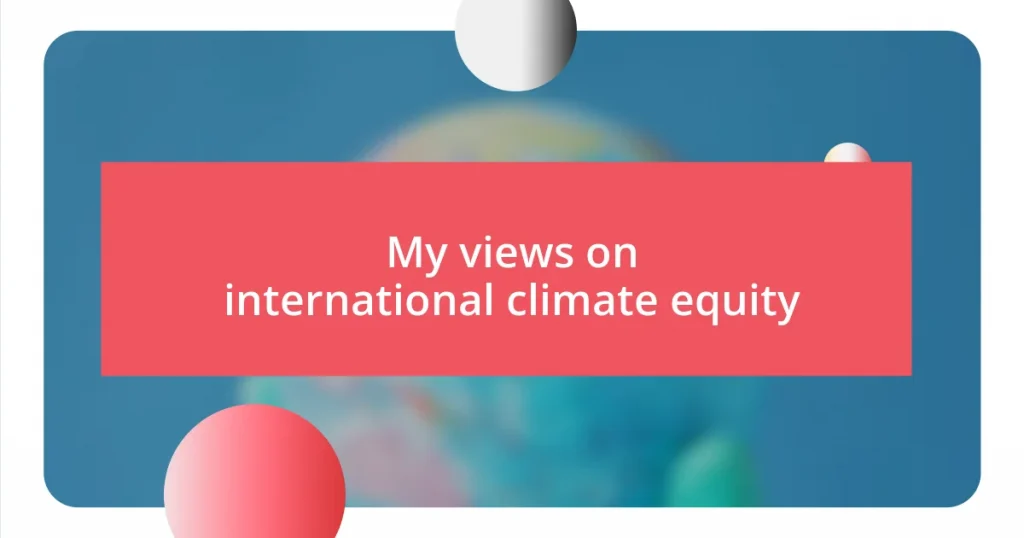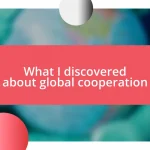Key takeaways:
- Climate equity emphasizes the need to prioritize support for vulnerable communities that contribute least to climate change but face the greatest impacts.
- International cooperation is essential for addressing global climate challenges, enabling resource sharing, and fostering innovative solutions that empower local communities.
- Developed nations have a duty to support developing nations through financial aid, technology transfer, and policy frameworks to promote environmental justice and equity.
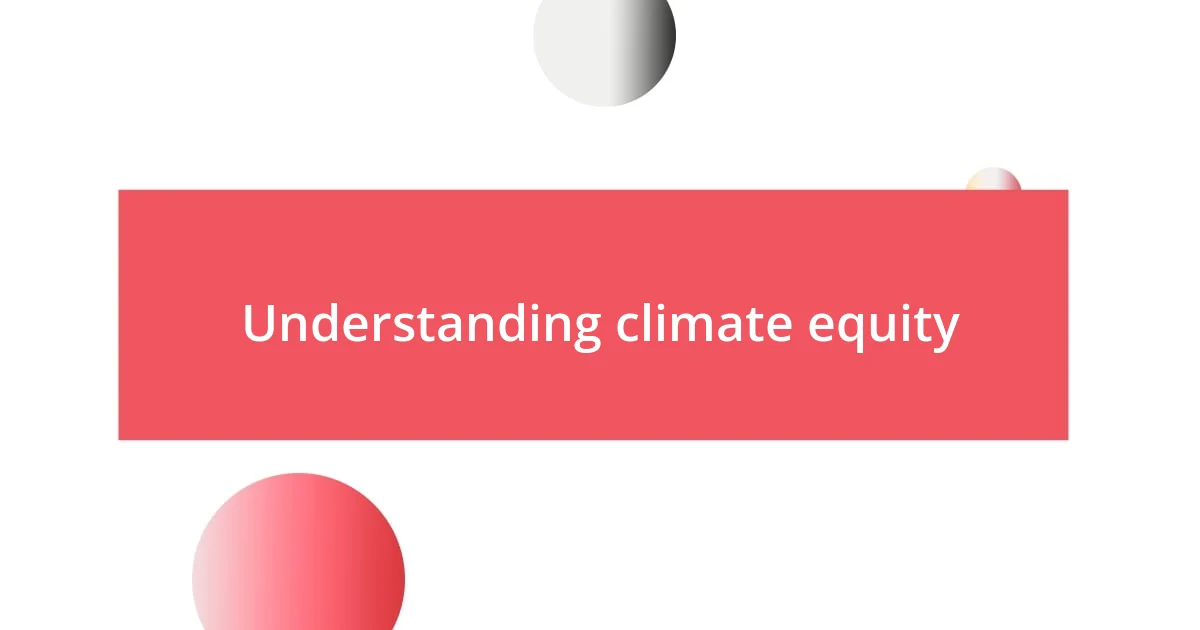
Understanding climate equity
Climate equity refers to the fair treatment of all people in relation to climate change impacts, ensuring that those who have contributed least to the problem—often the most vulnerable communities—are prioritized in support and resources. I remember visiting a small coastal village and witnessing firsthand how rising sea levels dramatically affected the livelihoods of local fishermen. It’s heartbreaking to think that communities like this are often ignored while contributing so little to the pollution that causes such drastic changes.
As I reflect on climate equity, I can’t help but ask: how can we justify the imbalance in responsibility and support? Those in wealthier nations, who have historically been the largest polluters, often have the resources to adapt, whereas developing nations struggle to cope with the impacts. This disparity can feel frustrating, especially when I see passionate grassroots movements advocating for environmental justice but still facing uphill battles against systemic issues.
Understanding climate equity isn’t just an environmental concern—it’s a matter of social justice. It’s about recognizing that an interconnected world demands collective action, not just from individuals, but governments and corporations. I often think about the ripple effects of climate policies and wonder: are we truly doing enough to uplift marginalized voices? Engaging with this question inspires me to learn more about participatory approaches in climate decision-making that prioritize equitable solutions for all.

Importance of international cooperation
International cooperation is absolutely vital in addressing the climate crisis, as the challenges we face are global in nature. I recently attended an international climate summit where delegates from various countries shared their unique perspectives. It was eye-opening to see how interconnected our destinies are; the air we breathe and the oceans we rely on don’t recognize borders. Each nation has its strengths and weaknesses, and when we pool our resources and knowledge, we can construct more robust and equitable solutions.
Fostering collaboration can also lead to innovative technologies and practices that benefit everyone. During a conversation with a renewable energy expert, I learned about a project that helped create affordable solar energy systems in underdeveloped areas. This collaborative effort not only provided clean energy but also empowered local communities economically. It’s this kind of synergy that encourages me to believe in the potential for international efforts to yield sustainable results.
Without effective international cooperation, the reality is that many countries may face dire consequences without adequate support. I recall a documentary showcasing how deforestation in one part of the world affects weather patterns far away. It’s a striking reminder that our actions echo globally, and if we don’t work together, the ripple effect could lead to widespread devastation. Engaging in collaborative efforts to address climate equity is essential; it reminds us that we ultimately share one fragile planet, and our survival depends on mutual respect and responsibility.
| Aspect | Importance of International Cooperation |
|---|---|
| Global Challenges | Climate issues cross borders, requiring unified efforts for effective solutions. |
| Resource Sharing | Pooling knowledge and technology can lead to innovative, equitable solutions. |
| Empowerment | Collaborative projects can uplift vulnerable communities and create economic opportunities. |
| Consequences of Inaction | Lack of cooperation can exacerbate global problems, affecting all nations. |
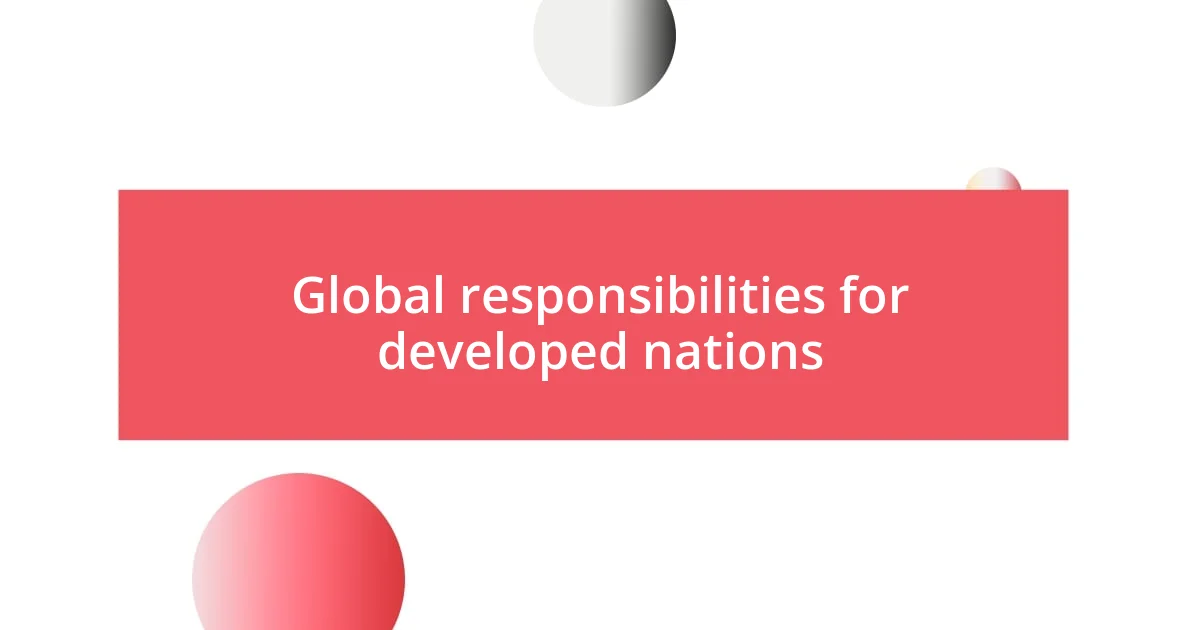
Global responsibilities for developed nations
Developed nations bear a significant responsibility in addressing global climate equity, especially given their historical roles as major contributors to greenhouse gas emissions. I vividly recall visiting an urban center in a developed country where I was struck by the contrast between the extreme weather events affecting nearby rural areas and the relatively mild conditions the urban population faced. It’s a stark reminder of how disparities in resources and infrastructure can shield wealthier communities, while others bear the brunt of climate-related challenges.
To address these disparities, developed nations can take action in several important ways:
-
Financial Support: Providing funds and resources to help developing nations implement sustainable practices and resilience strategies.
-
Technology Transfer: Sharing advanced renewable technologies that can expedite the transition to clean energy in less advantaged regions.
-
Capacity Building: Investing in education and training programs to empower local communities to take charge of their environmental futures.
-
Policy Frameworks: Leading by example with legislation that prioritizes environmental justice and equitable practices both domestically and internationally.
It’s crucial to remember that behind every statistic about climate change, there are real people whose lives are affected. I often think about the communities I’ve met, whose resilience should be recognized and supported. Their stories fuel my belief that developed nations must step up; it’s not just a matter of moral obligation but of shared humanity.
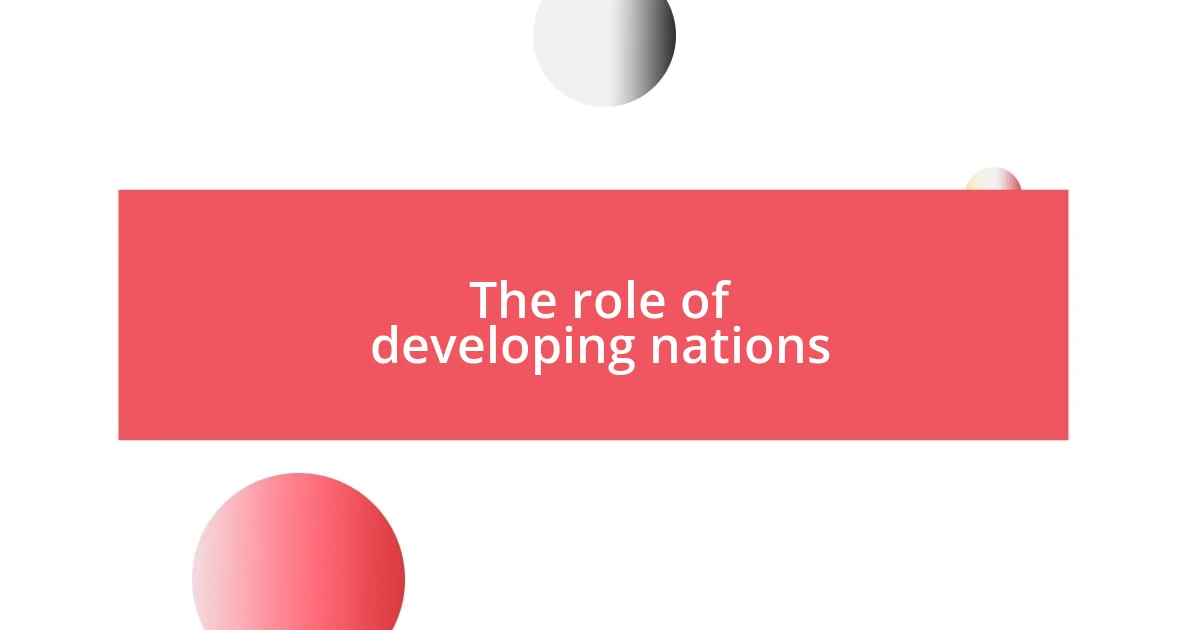
The role of developing nations
The role of developing nations in tackling climate change is both significant and nuanced. I remember chatting with a farmer during my travels in a developing country, listening to how shifting rainfall patterns were affecting their crops. It struck me that these communities often face the harshest consequences, despite contributing the least to the problem. This reality showcases the urgent need for developing nations to engage actively in climate discussions, as their unique experiences can inform global strategies effectively.
Moreover, these nations are rich in potential solutions that can drive climate action. For instance, in a small village, I observed a group of women innovating ways to utilize local natural resources sustainably. They developed a community garden that not only provided food but also drew carbon from the atmosphere. Their ingenuity demonstrates that developing nations, often perceived as needing help, can also be vital contributors to collective solutions. Isn’t it inspiring to see that resilience and creativity flourishing even in the face of adversity?
In many ways, developing nations serve as living laboratories for adaptation strategies. I once visited a coastal community that had implemented local measures to combat rising sea levels, showcasing their adaptability and willingness to take initiative despite limited resources. These efforts highlight the importance of amplifying their voices on the global stage. It’s crucial that we recognize and celebrate these contributions, as they are not just victims of climate change; they are active players with invaluable knowledge and insight to share. What if we shifted our perspective and acknowledged their role as partners in this global quest for climate equity? Wouldn’t that foster a deeper sense of collaboration?
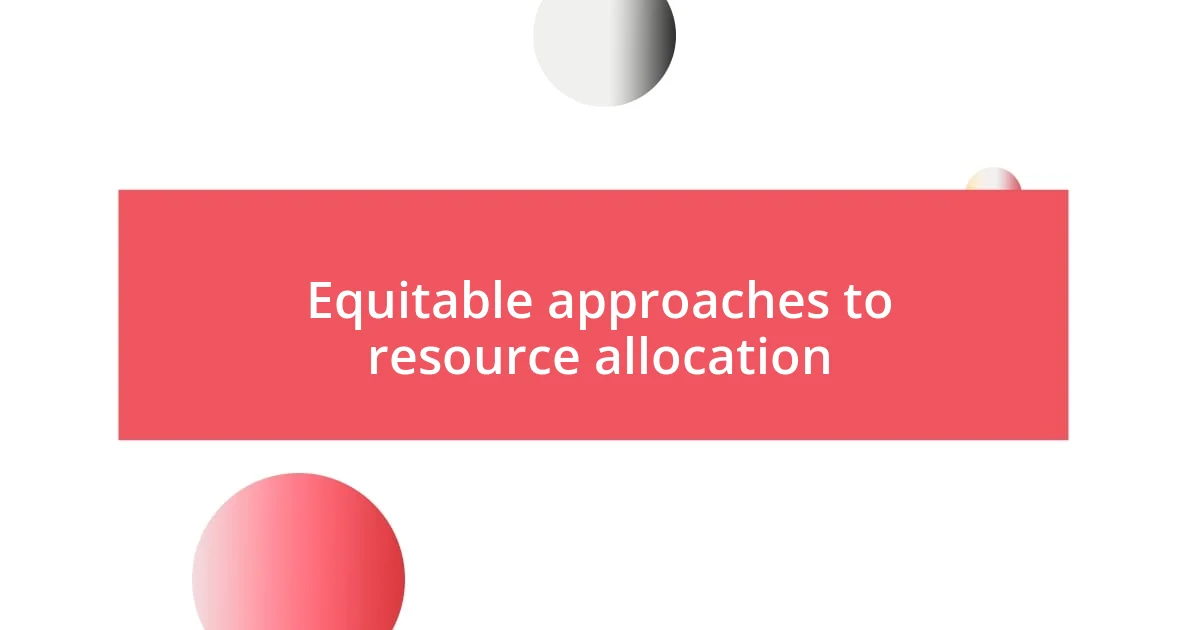
Equitable approaches to resource allocation
When discussing equitable approaches to resource allocation, I believe it’s essential to recognize community needs first. For instance, during an outreach project I worked on, we assessed the specific environmental challenges faced by a village grappling with unexpected droughts. Listening to local residents share their insights not only informed how we distributed water conservation tools but also highlighted that solutions should be tailored to unique situations, rather than one-size-fits-all strategies.
I also feel strongly about involving marginalized voices in the decision-making processes. In a workshop I attended, representatives from underrepresented communities voiced their concerns about resource distribution. The passion and urgency in their words were palpable, reminding me that equitable allocation isn’t just an abstract concept—it’s about real people who must navigate the day-to-day impacts of inequitable systems. How do we ensure everyone’s voice is not only heard but valued when it comes to resource sharing?
Finally, I often reflect on how financial resources—when allocated equitably—can lead to transformative change. During a visit to an empowerment initiative funded by donations, I saw firsthand how access to microloans enabled women to start small businesses in environmentally sustainable sectors. This experience illuminated the potential ripple effects of equitable funding. Imagine if every community had similar access to these types of resources—what incredible innovations could emerge in the fight against climate change?

Strategies for sustainable development
Sustainable development demands a multifaceted approach, and I believe education plays a pivotal role in this journey. I once attended a seminar in a rural area where local educators shared their innovative methods for integrating sustainability into school curricula. It was inspiring to see young students engaged in hands-on projects like building solar cookers. This early exposure fosters a culture of sustainability, equipping future generations with the skills and knowledge they need to address environmental challenges. How can we not prioritize education as a cornerstone of sustainable development?
Another crucial strategy involves prioritizing renewable energy sources. I recall visiting a community where wind turbines powered homes. The locals told me how embracing renewable energy not only reduced their carbon footprint but also created jobs and improved their overall quality of life. Their enthusiasm was infectious; they understood that sustainable energy was more than just a trend—it was a lifeline. What if more communities could experience the benefits of renewable energy? Imagine the collective impact we could have on climate change!
Collaboration across sectors cannot be overlooked. During a conference I attended, representatives from businesses, governments, and non-profits came together to share their insights. It struck me that their diverse perspectives led to innovative solutions that none could have achieved alone. One project—a partnership between local farmers and tech companies to promote precision agriculture—was particularly noteworthy. This cooperative effort not only boosted yields but also minimized environmental impact. Isn’t it clear that when we work together, we can create sustainable solutions that resonate beyond borders?
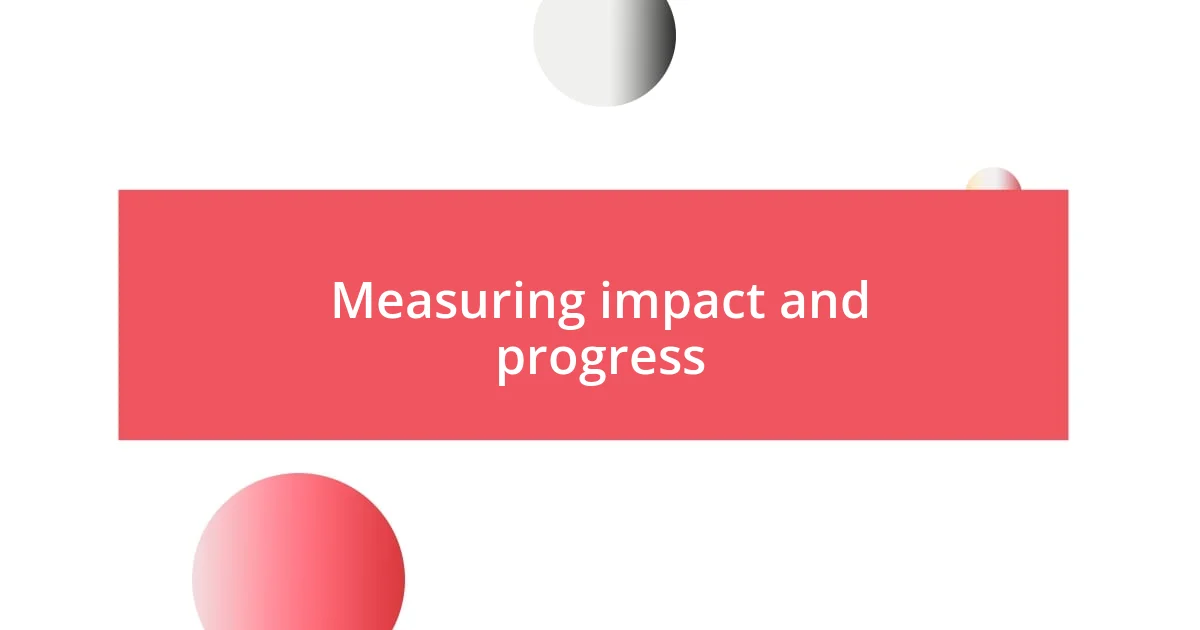
Measuring impact and progress
When it comes to measuring impact and progress in international climate equity, I find qualitative data incredibly enlightening. Once, while reviewing a remote community’s progress report, I was moved by personal stories shared in a local gathering. A farmer recounted how financing for crop diversification not only improved his yields but also strengthened his family’s resilience against climate shocks. These human elements often tell a more profound story than statistics alone, illustrating the difference equitable policies can make.
Quantifying success, on the other hand, provides essential markers for accountability. During a project evaluation I participated in, we utilized a set of key performance indicators (KPIs) to track changes in carbon emissions and community well-being. The data revealed that, within just a year of implementing equitable resource distribution, the area saw a 15% reduction in emissions alongside improvements in health metrics. It’s fascinating to consider: what does it mean for our collective future when we can measure such tangible progress?
I also believe that feedback loops play a vital role in driving continuous improvement. I remember being part of a feedback session with community leaders where they expressed their experiences with climate initiatives. Their candid responses not only highlighted successes but also pointed out areas needing more attention, much like a compass guiding our shared journey toward equity. As I reflect on this, I can’t help but wonder: how often are we truly listening and adapting our approaches based on ground-level insights?










